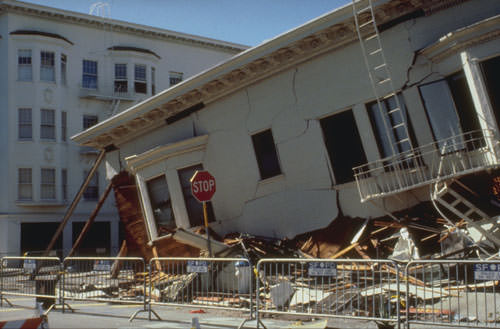There are two main types of earthquakes: natural and man-made. Naturally occurring(tectonic) earthquakes occur along tectonic plate lines(fault lines) while man-made earthquakes are always related to explosions detonated by man.
Tectonic earthquakes will occur anywhere there is sufficient stored elastic strain energy to drive fracture propagation along a fault plane. Plate boundaries move past each other smoothly and aseismically if there are no irregularities or asperities along the boundary that increase the frictional resistance; however, most boundaries do have such asperities that lead to stick-slip behavior. Once the boundary has locked, continued relative motion between the plates leads to increasing stress and stored strain energy around the fault surface. The energy increases until the stress breaks through the asperity, suddenly allowing sliding over the plate and releasing the stored energy. This energy is released as a combination of radiated elastic strain seismic waves, frictional heating, and cracking of the rock, which all adds up to an earthquake. This process is called the elastic rebound theory. It is estimated that only 10 percent or less of an earthquake’s total energy is radiated as seismic energy. Most of the earthquake’s energy is used to power the fracture growth or is converted into heat generated by friction.
Occasionally, naturally occurring earthquakes happen away from fault lines. When plate boundaries occur in continental lithosphere, deformation is spread out over a much larger area than the plate boundary, so earthquakes occur away from the plate boundary and are related to strains developed within the broader zone of deformation caused by major irregularities in the fault trace. Also, all tectonic plates have internal stress fields caused by their interactions with neighboring plates and sedimentary loading or unloading. These stresses may be sufficient to cause failure along existing fault planes, giving rise to intraplate earthquakes.
The other type of earthquake is the artificial or man-made quake. This type of quake has been felt all over the world after the detonation of a nuclear weapon. There is very little actual data that is readily available on this type of quake, but, of the two types of of earthquakes it is the only type that can be easily predicted and controlled.
We have written many articles about earthquakes for Universe Today. Here’s an article about how earthquakes happen, and here’s an article about famous earthquakes.
If you’d like more info on earthquakes, check out the U.S. Geological Survey Website. And here’s a link to NASA’s Earth Observatory.
We’ve also recorded related episodes of Astronomy Cast about Plate Tectonics. Listen here, Episode 142: Plate Tectonics.
Sources:
Types of Earthquakes
http://en.wikipedia.org/wiki/Earthquake
http://earthquake.usgs.gov/learn/topics/plate_tectonics/rift_man.php

